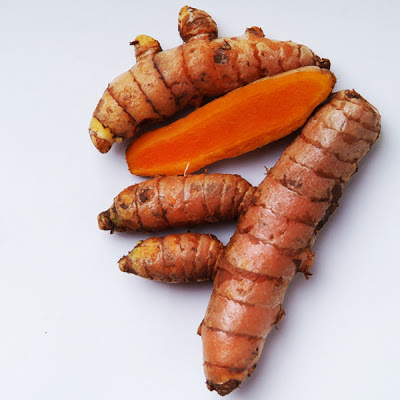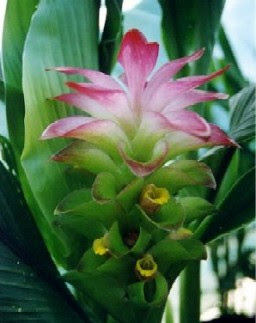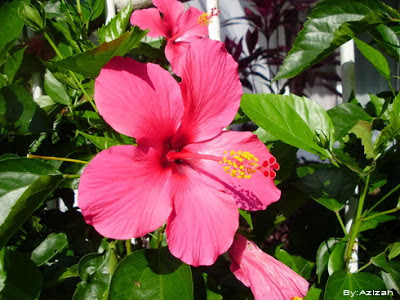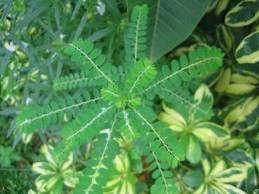As a first aid measure, traditional medicine can be relied upon to overcome the fever.
MANY parents panic when his son discovered the body temperature above the average or commonly called fever. As first aid, usually given febrifuge based chemicals such as paracetamol group, salicylic acid, ibuprofen, and others. Rarely do parents who immediately thought of giving traditional medicines.
In fact, traditional medicines derived from medicinal plants is not less powerful this as a repellent fever. In fact, traditional medicine has its advantages, the relatively lower toxicity than chemical drugs. Thus, relatively more safe, no side effects even when use correctly. You see, the content is complex and medicinal plants that can be compared to organic food, a substance that is consumed in order to reconstruct the damaged organ or system. In addition, the price is cheaper.
Three Types of Fever
However, before to know more about febrifuge plant, needs to be understood first understanding fever. Fever in children can be divided into three, namely:
1. Fever due to an infection where the temperature can reach more than 38 ° C. The causes vary, namely viral infections (such as flu, chicken pox, measles, SARS, bird flu, dengue fever, etc.) and bacteria (typhoid fever, sore throat, etc.).
2. Non-infectious fever, such as cancer, tumor, or the presence of one autoimmune disease (rheumatoid arthritis, lupus, etc.).
3. Physiological fever, such as lack of fluids (dehydration), the temperature is too hot, and others.
Well, of the three, only the fever caused by infection and non-infectious alone requires febrifuge. To speed up the process of decline in the heat, in addition to traditional herb is taken, may also be given to help the glaze or compress.
As for physiological fever, unnecessary medicines for fever as most rarely exceed 380 ° C. To lower body temperature, given enough to drink a lot and are cultivated in a well-ventilated room or refrigerated.
Various Heat Reducer Traditional Medicine
Here are some traditional choices febrifuge that can be tried. Important note, the doses listed on the following formula is the dosage for adults. If you want to give to a child, read the rules and adjust the dose for children with age levels. (See box: Safe Dose for Children.)
1. Lempuyang Emprit (Zingiber amaricans)
 |
pic : foragri.blogsome.com
|
Compounds contain essential oils, which sekuiterpenketon useful to reduce the heat. Commonly used is the rhizome; yellowish white color and tastes bitter.
How: Rinse 10 grams of tubers lempuyang CVD. Grate and add 1/2 cup hot water and stir well. Once cool, squeeze, take the juice. Toss with 2 tablespoons (tbsp) cotton flower honey and stir well. Give 3 times a day.
2. Turmeric (Curcuma longa)
 |
wong168.wordpress.com
|
Contains oil, curcumin, and zingiberen turmeron which can be useful as an antibacterial, antioxidant, and anti-inflammatory (anti-inflammatory). Besides the fever, this mixture also can increase endurance. Commonly used is the rhizome; orange color.
How: Rinse 10 grams of turmeric root. Grate and add 1/2 cup hot water and stir well. Once cool, squeeze, take the juice. Add the juice of 1/2 lime fruit. Toss with 2 tablespoons cotton flower honey and stir well. Divided into 3 parts honey and turmeric, then give it 3 times a day.
3. Bitter (Andrographis paniculata)
 |
pic : rahasiakeluarga.com
|
The entire plant can be used. Andrographolide lactones (bitter substances), diterpene, glucosides and flavonoids that may reduce the heat. Even in 1991 had conducted research in Thailand that bitter 6 g per day was as effective as paracetamol.
How: Boil 10 grams of dried bitter leaf, 25 g of dried turmeric root (2.5 thumb), and 200 cc of water. Boil until the water boils and stay 100 cc, then strain. Once warm, add 100 cc or mahogany cotton flower honey and stir well. Divided into 3 parts, give it 3 times a day.
4. Gotu kola (Centella asiatica L.)
 |
pic : nugroho-sayang-resty.blogspot.com
|
Plants are also known by the name of the horse's foot leaves grow creeping ground cover. The leaves are green and shaped like a kidney fan. Contains triterpenoids, saponins, hydrocotyline, and vellarine. Useful to reduce heat, revitalizing the body and blood vessels as well as to strengthen the structure of body tissues. Gotu kola also be cool or cool, add energy and unappetizing meal.
How: Boil 1 handful fresh gotu kola with 2 cups water to boiling and 1 cup water. Divided into 3 parts and drink 3 times a day.
5. Turmeric (Curcuma xanthorhiza Roxb.)
 |
pic : tanamanherbal.wordpress.com
|
Ground ginger look like white, only different colors of flowers and rhizomes. White ginger flowers yellow or light yellow, while the white ground is white with a red edge. Brownish orange ginger rhizome, while the rhizome part in white light yellow ground.
Wild Ginger has germacrene active substance, xanthorrhizol, alpha beta curcumena, and others. Benefits as anti-inflammatory (antiperandangan), antibiotics, and increase the production and secretion of bile. Ginger since the first widely used as febrifuge, stimulate appetite, treat jaundice, diarrhea, ulcers, abdominal bloating and fatigue.
How: Rinse 10 grams of ginger rhizome. Grate and add 1/2 cup hot water and stir well. Once cool, squeeze, take the juice. Toss with 2 tablespoons cotton flower honey and stir well. For a third of honey and ginger, then give it 3 times a day.
6. Onion (Allium cepa L.)
 |
pic : wong168.wordpress.com
|
Shallots are often used as a spice in the kitchen. Contains oil, sikloaliin, metilaliin, kaempferol, quercetin, and floroglusin.
How: Peel 5 grains of red onion. Coarsely grated coconut and add the oil to taste, then smeared into the crown and the entire body.
7. Leaf hibiscus (Hibiscus rosa sinensis)
 |
pic : beautyinsect.blogspot.com
|
Apart from hibiscus leaves, you can also avail of cottonwood leaves or betel leaves. Hibiscus contains flavonoids, saponins and polyphenols. Cottonwood leaves contains flavonoids, saponins and tannins. Betel leaf contains flavonoids, saponins, polyphenols, and essential oil.
How: Rinse the leaves, dry them with a clean cloth, reheat briefly over the fire so limp. Knead so limp, spread with coconut oil, kompreskan in the stomach and head.
8. Meniran (Phyllanthus niruri L.)
 |
pic : djamilah-najmuddin.com
|
Reaches 1 meter high plants, growing wild, leaf-shaped compound leaves finned quite even. All parts of this plant can be used. Contains lignans, flavonoids, alkaloids, triterpenoids, tannins, vitamin C, and others. Useful to reduce heat and increase endurance.
How: Boil 1 handful fresh meniran with 2 cups water to boiling and 1 cup water. Divided into 3 parts and drink 3 times a day.
9. Coconut water
 |
pic : dapurherbalku.wordpress.com
|
Young coconut water contains many minerals, such as potassium. At the time of the heat, the body will expend a lot of sweat to lower body temperature. Well, to replace sweat that out, multiply drinking coconut water.
Dose Safe for Children
The use of medicinal plants with the proper dose will not cause any side effects and is safe. These doses are recommended for children:
Minimum Dose
Baby 1/8 adult dose
2-5 years quarter adult dose
6-9 years 1/3 adult dose
10-13 years half adult dose
14-16 years 3/4 adult dose
No comments:
Post a Comment